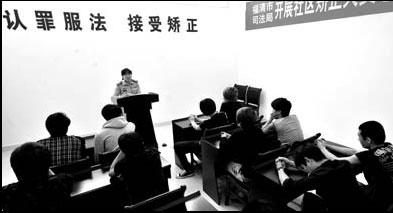Legal Special: Community corrections give second chance
Updated: 2013-01-08 07:53
By Jiang Aidong (China Daily)
|
||||||||
|
The offenders receive lectures from local police Chen Hui in Fuqing city, Fujian province, as part of China's community corrections system. Wei Peiquan / Xinhua |
Community corrections refers to activities other than imprisonment that are intended to correct the criminal psychology and bad behavioral habits of criminals who are qualified for it.
This type of corrections is carried out by special State organs, with the assistance of relevant social, civil and volunteer organizations. The duration of the process is established by court adjudication, and the aim of the program is to make it easier for criminals to return to society.
China started pilot programs for community corrections in 2003 and put the system into trial use nationwide from 2009. The process has already been established as a legal system.
The core issue of community corrections is to improve educational and correctional aspects of China's justice system.
Before the court decides to allow a criminal's imprisonment to be deferred to the community corrections system, judicial authorities at the county level are authorized to investigate and evaluate the criminal's influence on his or her community during the corrections period, according to the Measures of the Implementation of Community Corrections.
The authorities can make a suggestion based on their understanding of where the criminal lives as well as his or her family, social connections, criminal record, the impact of his or her crimes, and advice of the neighborhood, and afterward they will submit the evaluation that will be used as a reference when making the final decision on eligibility for the program.
Past experience has shown that the evaluation and investigation process helps authorities make right decisions and draft correctional plans that are most suitable for different criminals while making the best use of related departments at various levels.
Specific rules have been made regarding registration, reporting changes of address, reporting movements, education and study, and disciplinary actions for violating rules.
The correctional team is made up of law enforcement personnel, volunteers, community corrections staff and coworkers, teachers and family members of the criminals. The teams strengthen their supervision of criminals through dialogues and visits. A mobile phone positioning system is even used for real-time supervision in some places.
The main components of education for criminals are - ideological, legal, social, moral and civil. They can also be organized to do public sanitation, look after elderly people without families, take care of greenbelts and plant trees, as well as the other community service to repair their social connections and raise their awareness of morals and positive behavioral habits.
Based on the type of crime committed as well as the criminal's characteristics and family conditions, teams should start psychological corrections for individual cases. This is done by providing consultation and education for them and teaching them steps to mitigate the effects of a psychological crisis, thereby consolidating the results of community corrections.
Criminals involved in the community corrections process should be covered by income subsidies for city residents if they are qualified. Qualified rural criminals should have contracted farmland so that they can make a living for themselves.
If needed, skills training and employment guidance should also be provided for those involved in community corrections.
The community corrections system must be implemented through the collaboration of different departments of various levels. Judicial administrations are responsible for the administration and guidance of the work. County-level judicial departments and community correction organs are supervisors as well as service, assistance and education providers. The grassroots offices of justice are in charge of the daily work of community corrections.
The courts can investigate and evaluate potential eligibility for community correction and pay a follow-up visit to the community to learn about progress made toward rehabilitation. The procuratorates are in charge of supervision of law enforcement at all stages of the process. The public security departments should lawfully deal with the criminals in the community corrections system who violate security administration rules or commit crimes again during the period of corrections.
The social security, civil affairs, industry and commerce administrations, and taxation departments should provide subsistence allowances, employment guidance and assistance for the criminals to help them solve problems in their lives. The financial department should provide necessary funds for community correction works.
Various social organizations and powers are welcome to participate in community corrections. Specialists, scholars, retirees, and college students are all encouraged to participate in the work as volunteers. Government entities at all levels should cooperate with NGOs actively in this field.
As of the end of September, about 1.17 million people had participated in community corrections across China. Around 514,000 people are in the system now. Most of the people take this opportunity to reform themselves seriously. Their sense of social responsibility and awareness of the law has been obviously raised.
The author is director of Community Correction Administration Bureau of the Ministry of Justice.
For China Daily
(China Daily 01/08/2013 page5)

 In Photos: 7.0-magnitude quake hits Sichuan
In Photos: 7.0-magnitude quake hits Sichuan
 Li Na on Time cover, makes influential 100 list
Li Na on Time cover, makes influential 100 list
 FBI releases photos of 2 Boston bombings suspects
FBI releases photos of 2 Boston bombings suspects
 World's wackiest hairstyles
World's wackiest hairstyles
 Sandstorms strike Northwest China
Sandstorms strike Northwest China
 Never-seen photos of Madonna on display
Never-seen photos of Madonna on display
 H7N9 outbreak linked to waterfowl migration
H7N9 outbreak linked to waterfowl migration
 Dozens feared dead in Texas plant blast
Dozens feared dead in Texas plant blast
Most Viewed
Editor's Picks

|

|

|

|

|

|
Today's Top News
Live report: 7.0-magnitude quake hits Sichuan, heavy casualties feared
Boston suspect cornered on boat
Cross-talk artist helps to spread the word
'Green' awareness levels drop in Beijing
Palace Museum spruces up
First couple on Time's list of most influential
H7N9 flu transmission studied
Trading channels 'need to broaden'
US Weekly

|

|








